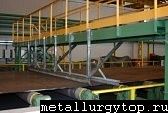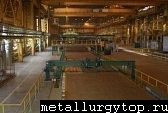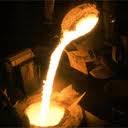A Brief History of Sheffield
 Sheffield lies in the North of England, about 65 kilometers east of Manchester in South Yorkshire. Chartered as the City of Sheffield in 1893 due to it's origins in a field on the River Sheaf. The population tops a half million citizens now, with a workforce over a million strong residing within an hours drive of the city. Sheffield's fortunes have long been shaped by world events and external forces that forced the residents of Sheffield to adapt and innovate in order to survive.
Sheffield lies in the North of England, about 65 kilometers east of Manchester in South Yorkshire. Chartered as the City of Sheffield in 1893 due to it's origins in a field on the River Sheaf. The population tops a half million citizens now, with a workforce over a million strong residing within an hours drive of the city. Sheffield's fortunes have long been shaped by world events and external forces that forced the residents of Sheffield to adapt and innovate in order to survive.
Sheffield Castle was built after the Norman Conquest to oversee the local settlements in what is now the heart of the city. The market that grew around the Castle, in what is now Castle Square, made Sheffield a market town just prior to 1300 A.D. Over the next century, Sheffield became well known for the fine cutlery that was produced and sold there, and by 1600 the town was the known to be the center of Cutler Production in all of England, earning a mention in Chaucer's «The Canterbury Tales».
Sheffield was on the «cutting edge» so to speak of cutlery technology in those early years, and the invention and improvement of several processes in the mid 1700's revolutionized metallurgy. Crucible Steel and silver plating placed Sheffield squarely in the lead in metallurgy in the world. Sheffield grew as an industrial center, and was a great producer of steel until a recession from the loss of import markets at the end of the 18th century. Conditions in the city deteriorated, and a cholera epidemic killed over 400 people in 1832. The huge amounts of wealth created by the large steel producers tended to stay at the top of the hiarchy, while the unchecked pollution, overcrowding, and disease made its way to the masses.
The start of the industrial revolution brought people back to the city over the next few decades, and clean drinking water was necessary to avoid the deadly diseases of 1832. New reservoirs built on the outskirts of the city helped keep the water supply disease free, but the collapse of a dam wall at one site in 1864 caused the Great Sheffield Flood, which resulted in the deaths of 270 people and widespread damage to the city.
The early 1900's saw Sheffield again noted in literature as George Orwell called Sheffield the «Ugliest town in the Old World„ in “The Road to Wigan Pier» written in 1937. The combination of quickly built slums to house the growing numbers of working people, and the pollution from the factories they manned made Sheffield a less than attractive city. The invention of stainless steel in 1913 by a Sheffield resident steel producer bolstered the industry, but at the cost of the beauty of the city founded at the confluence of five rivers. The hills around the city vary from 10 to 500 meters above sea level forming a natural amphitheater. By the end of the 1930's a recession that paralleled «The Great Depression» in the U.S. had taken a toll on all industrial areas, and Sheffield was no exception.
That recession was soon over as European factories began gearing up for war. Sheffield quickly regained its spot as a world class steel producer, making weapons and ammunition for the coming World War. The very same industry that had made Sheffield prosperous during the good times, also made it perilous during the bad times. World War II made Sheffield a vital weapons and munitions manufacturing center, which in turn made it a target for Luftwaffe bombers. Three nights of air attacks known as the «Sheffield Blitz», killed 660 and wounded another 1,500 residents. 40,000 others were left homeless by the air raids as 3,000 homes were demolished and another 3,000 severely damaged. All toll 78,000 homes were damaged to some degree.
After the war, Sheffield continued as a major player in the steel industry. Cutlery was still a big industry in Sheffield. Over half of the world's surgical blades are produced in Sheffield to this day. Rebuilding the city after the war was a success, not only clearing the slums, but investing in infrastructure and park areas to beautify the city, and roads to get people to work at the steel mills. Sheffield was awash with prosperity during the years following World War II. Steel for reconstruction was needed all over Europe, Russia, Japan, the South Pacific and many other areas.
Rebuilding Industry in Germany, and Japan was a double edge sword, as the steel for their rebuilding meant busy steel mills around the world. The end result was that as industry labored to keep up rebuilding German and Japanese industry, it did not keep up with the automation, and process improvement systems that would soon drive many of them out of business, not allowing them to compete against the factories they helped build.
The late 1970's and 1980's saw Steel mills that could not compete close down throwing thousands into unemployment. A mid 80's miner's strike did not help matters either, and the industrial backbone of Sheffield was snapped. Again noted, not so much in literature, but in a movie, The Full Monty chronicled some young and not so young Sheffield residents who were force to change occupations as when their long and hopeless job searches were not panning out.
The movie itself was not only hilarious, but intriguing because the money brought into the cities economy when a movie is shot there is exactly the type of economic boost former industrial centers require when moving from a manufacturing economy to a service economy. Other movies with Sheffield roots were: Threads, When Saturday Comes, F.I.S.T., and Whatever Happened to Harold Smith. Sheffield has also produced its share of entertainers. Actors like Sean Bean who's recent credits include, «Patriot Games«, «National Treasure", and »Flight Plan». David Bell starred in »Cross–eyed Waltz" and Thomas Craig a former Sheffield Plummer with over 30 television credits on his resume.
Sheffield is also fertile ground for musicians. Local acts that made it big include Pulp, The Artic Monkeys, Joe Cocker, the Long Pigs, and 65daysofstatic. Sheffield is also the center of the Yorkshire Hip Hop and R&B scenes. Talented local acts like «NoXcuse„ and “Hoodz Underground» are local headliners and celebrities in and around Sheffield.
Sheffield still supports industry, including steel, mining, and cutlery, but its economy is diversifying the way many cities in the world are, trying to compete in a global economy. Sheffield will not be mistaken for Hawaii as a tourist spot anytime soon, but they seem to be doing a lot of the right things to create a competitive economy for the coming years. Often with industrial job loss, poverty and blight soon follow, and the inherent rise in crime draws people away from the cities center.
Creativity, culture, tourism, sporting events, and service industries are ways to avoid economic ruin for a city in transition. Sheffield has all that, as well as great educational facilities that support 45,000 university students. If used and marketed correctly that spells a bright future for the city of Sheffield. The fact that Sheffield is one of the safest cities in the U.K. according to government statistics shows the typical problems with economic transition have not affected the city. Manufacturing provides only 14% of the jobs now, while service industry positions account for 82%. Far behind are Health Care, and technology sector jobs.
Plenty of attractions including National Park land within the city boundaries help keep the educated university students from bolting upon graduation. That in turn insures economic, and technological improvements for years to come, helping Sheffield to be at the forefront of economic development for the future.





The Tough Job of Metal Fabrication
 One of the most abundant natural elements present in this world is metal. Metals are discovered during the ancient times. During those early years the main role of metal is to protect the people from war. The early civilizations have managed to extract and form metals as weapons against their enemies. It served as their greatest form of weapon to save them from the danger of war.
One of the most abundant natural elements present in this world is metal. Metals are discovered during the ancient times. During those early years the main role of metal is to protect the people from war. The early civilizations have managed to extract and form metals as weapons against their enemies. It served as their greatest form of weapon to save them from the danger of war.
Nowadays these natural materials became really helpful to human beings. Metallurgy is a branch of science that deals with the natural evolution and history of metals. If you are really interested with metals you can surely enjoy the world of metallurgy.
When a person is being asked about what metal is, the thing that will form to his or her mind is that it is a sort of material which is very much known because of its hardness and durability. This idea is partly correct; however it is not the entire characteristics of metals. The hardness and durability of metals belong to a specific type of material which is the steel.
There are several types of metal present in this world. Silver and gold are known as the most expensive types of such materials. These metals are often used in making necklaces, bracelets, rings and other forms of jewelries. Copper have gained the interest of those who engaged in electrical engineering because it is one of the best conductors of electricity. However there is also a type of such material which is also feared because of its nature. Mercury is the only type of this natural material in a liquid state. It is often used in extracting gold and silver during the process of extraction.
Nevertheless steel became really popular and useful of all the types of metals. It has been used by most of the people in making different inventions. If you are still not convinced with the efficiency of the said material, you can roll your eyes over your surroundings and observe how these things have been really useful to humans. These resources became really useful to humans because of its natural characteristics. Malleability is one of the important characteristics of this stuff that help humans in forming it into their preferred shapes.
On the other hand it takes so much time before such materials are transformed into valuable ones. Metal fabrication is the method of extracting and processing metals into sheets and bars. Extreme heat or a high level of temperature is required during metal fabrication. Metal fabrication is often performed by men with great strengths and remarkable skills since this type of job requires such abilities.
Metal fabrication is also a way of recycling metals. Materials that are no longer used and are junked in different places are being recycled during metal fabrication in order to make use of it once again. Since it takes millions of year before this material vanished away, it can be transformed and recycled into different forms. Metal fabrication is one of the most important methods used to preserve the presence of metals in this world.





Metallurgy Zone - What Is Metallurgy?
 Metallurgy is the study of the properties of metal, the procedure of extracting them from the grounds and the procedure in refining, alloying and making things out of the metals. A metallurgist is the engineer or person who specializes in metallurgy. It is a requirement for a metallurgist to have a knowledge in geology, since extraction of metals is heavily implicated with study of soil, minerals and other structures of the earth and understanding of these thing are very important to people who are working with metals.
Metallurgy is the study of the properties of metal, the procedure of extracting them from the grounds and the procedure in refining, alloying and making things out of the metals. A metallurgist is the engineer or person who specializes in metallurgy. It is a requirement for a metallurgist to have a knowledge in geology, since extraction of metals is heavily implicated with study of soil, minerals and other structures of the earth and understanding of these thing are very important to people who are working with metals.
Metallurgists may be found working in broad variety of setting worldwide and employment forecasts in this kind of work are normally very good.
A mining metallurgist specializes in getting valuable metals coming from ores. He/she may be interested also in the procedure of alloying and purification, operating with metals in order to develop popular products and new metals that may be applied into a range of manufacturing problems. Physical and chemical metallurgists focus in the physical and chemical properties of metals, looking at objects which pressure metal like corrosion, fatigue, and heat changes.
To become a certified metallurgist, it is generally necessary to attend some training programs which provide chances to people interested in the career pertaining to metallurgy, from technical school which train people forging skills in a college or university curriculum. Several metallurgists can also obtain their expertise in college or university engineering curriculum.
Several metallurgists can also obtain their talent in the job, working under management at first and ultimately independently, even though this technique of studying metallurgy is slightly common. Metallurgists expend plenty of moment in the laboratory, learning metals and performing experiments. They may also work in melting facilities, checking the production and alloying the metals, and supervising the procedure in handling metal ores. Other performs for companies that utilize the services of metallurgist in engineering cars for utmost efficiency and safety.
They can also work private consultation firms and government firms, giving a variety of services from forensic examination into bridge breakdown to policy proposals that are designed to regulate metal products. A metallurgist may assist in the manufacture of jewelry and other work of arts that involve metals, organizing the alloy of metal utilized in jewelry to make sure that the metals remain in high quality, and assisting jewelers as well as sculptors formulate intricate custom projects.




